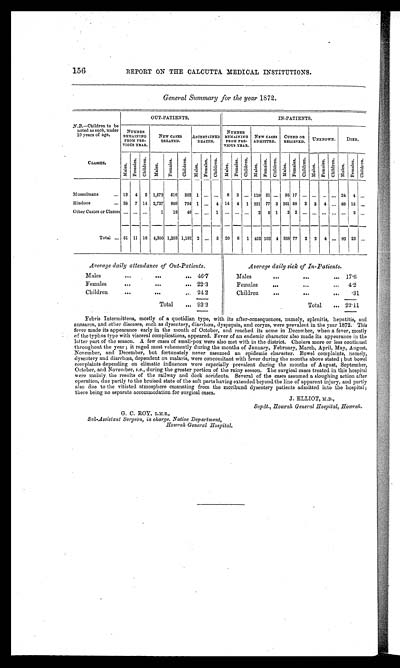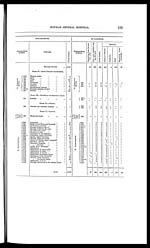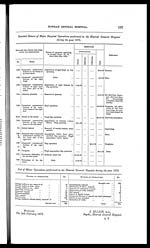Medicine - Institutions > Reports from medical colleges, schools and research institutions > Report on the Calcutta medical institutions > Calcutta medical institutions reports 1871-78 > Report on the Calcutta Medical Institutions for the year 1872
(260) Page 156
Download files
Individual page:
Thumbnail gallery: Grid view | List view

156
REPORT ON THE CALCUTTA MEDICAL INSTITUTIONS.
| General Summary for the year 1872. | ||||||||||||||||||||||||
| N.B.—Children to be noted as such, under 10 years of age. CLASSES. |
OUT-PATIENTS. | IN-PATIENTS. | ||||||||||||||||||||||
| NUMBER REMAINING FROM PRE- VIOUS YEAR. |
NEW CASES TREATED. |
ASCERTAINED DEATHS. |
NUMBER REMAINING FROM PRE- VIOUS YEAR. |
NEW CASES ADMITTED. |
CURED OR RELIEVED. |
UNKNOWN. | DIED. | |||||||||||||||||
| Males. | Females. | Children. | Males. | Female. | Children. | Males. | Females. | Children. | Males. | Females. | children. | Males. | Females. | Children. | Males. | Females. | Children. | Males. | Females. | Children. | Males. | Females. | Children. | |
| Mussulmans | 13 | 4 | 2 | 1,572 | 516 | 352 | 1 | ... | ... | 6 | 2 | ... | 119 | 21 | ... | 95 | 17 | ... | ... | .. | ... | 24 | 4 | ... |
| Hindoos | 38 | 7 | 14 | 2,727 | 669 | 794 | 1 | ... | 4 | 14 | 4 | 1 | 331 | 77 | 3 | 261 | 58 | 2 | 2 | 4 | ... | 68 | 15 | ... |
| Other Castes or Classes | ... | ... | ... | 1 | 18 | 46 | ... | ... | 1 | ... | ... | ... | 2 | 5 | 1 | 2 | 2 | ... | ... | ... | ... | ... | 3 | ... |
| Total | 51 | 11 | 16 | 4,300 | 1,203 | 1,192 | 2 | ... | 5 | 20 | 6 | 1 | 452 | 103 | 4 | 358 | 77 | 2 | 2 | 4 | ... | 92 | 22 | ... |
| Average daily attendance of Out-Patients. | Average daily sick of In-Patients. | ||||||||
| Males | ... | ... | ... | 46.7 | Males | ... | ... | ... | 17.6 |
| Females | ... | ... | ... | 22.3 | Females | ... | ... | ... | 4.2 |
| Children | ... | ... | ... | 24.2 | Children | ... | ... | ... | .31 |
| Total | ... | 93.2 | Total | ... | 22.11 | ||||
Febris Intermittens, mostly of a quotidian type, with its after-consequences, namely, splenitis, hepatitis, and
anasarca, and other diseases, such as dysentery, diarrhœa, dyspepsia, and coryza, were prevalent in the year 1872. This
fever made its appearance early in the month of October, and reached its acme in December, when a fever, mostly
of the typhus typo with visceral complications, appeared. Fever of an endemic character also made its appearance in the
latter part of the season. A few cases of small-pox were also met with in the district. Cholera more or less continued
throughout the year; it raged most vehemently during the months of January, February, March, April, May, August,
November, and December, but fortunately never assumed an epidemic character. Bowel complaints, namely,
dysentery and diarrhea, dependent on malaria, were concomitant with fever during the months above stated; but bowel
complaints depending on climatic influences were especially prevalent during the months of August, September,
October, and November, i.e., during the greater portion of the rainy season. The surgical cases treated in this hospital
were mainly the results of the railway and dock accidents. Several of the cases assumed a sloughing action after
operation, due partly to the bruised state of the soft parts having extended beyond the line of apparent injury, and partly
also due to the vitiated atmosphere emanating from the moribund dysentery patients admitted into the hospital;
there being no separate accommodation for surgical cases.
J. ELLIOT, M.D.,
Supdt., Howrah General Hospital, Howrah.
G. C. ROY, L,M.S.,
Sub-Assistant Surgeon, in charge, Native Department,
Howrah General Hospital.
Set display mode to: Large image | Zoom image | Transcription
Images and transcriptions on this page, including medium image downloads, may be used under the Creative Commons Attribution 4.0 International Licence unless otherwise stated. ![]()
| Permanent URL | https://digital.nls.uk/74973656 |
|---|
| Description | 13 titles. Describes research work and conditions, treatments, vaccine production, medical education, public health and disease outbreaks. Extensive tables show mortality rates and patient admissions. These - some from asylums, jails, dispensaries, civil and police hospitals – will be useful to epidemiologists. |
|---|




